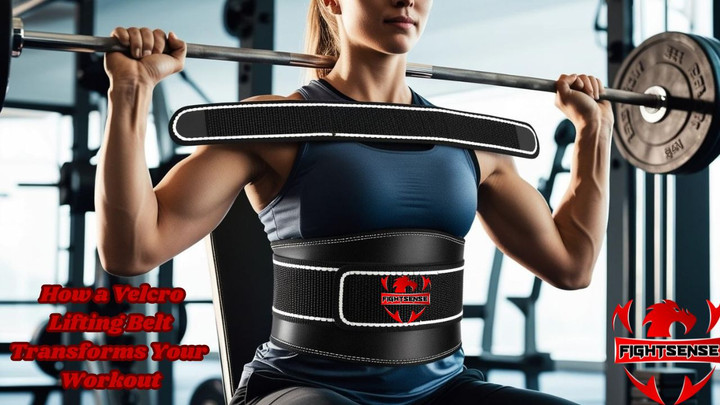How a Velcro Lifting Belt Transforms Your Workout
19th Mar 2025
A Velcro lifting belt can be the solution you need if you have ever battled to keep your form when lifting heavy weights. It is a seemingly basic workout item that has the potential to significantly improve your performance. What is the purpose of a Velcro lifting belt, and why should you consider purchasing one?
This blog will go over how this belt might improve your lifts, its advantages, and correct application techniques for optimum results.
Key Highlights:
-
By supporting your back and core, the Velcro lifting belt lowers your chance of injury during big lifts.
-
Compared to leather belts, it provides comfort, flexibility, and quick changes.
-
The material is perfect for moderate to heavy lifting but not as robust as leather for really heavy weightlifting.
-
Correct use calls for a tight fit and depending just on it for large compound lifts.
What is a Velcro Lifting Belt Used For?
A Velcro lifting belt is designed to provide your lower back and core with much-needed support during large lifts. Typically, people use it for complex workouts like deadlifts, squats, and overhead presses, where core stabilization plays a crucial role.
It helps with the following:
-
Core Support: It provides added stability during weightlifting by helping your core muscles to be active.
-
Lower Back Protection: Strong support helps lower back protection, thereby reducing your danger of straining it.
-
Posture and Alignment: It aids in maintaining proper posture and spine alignment during and this belt helps in weightlifting.
What Does Velcro Lifting Belt Do?
This exactly happens when you tighten the Velcro lifting belt around your waist:
-
Increases Intra-Abdominal Pressure: This pressure stabilizes your spine like a brace under heavy loads.
-
Supports Lower Back: Stabilizing your torso helps reduce unwelcome strain on your back during strenuous lifts.
-
Improves Posture: Maintaining an upright posture is essential for preserving correct form during exercises like squats and deadlifts; hence, a safe belt guarantees you to do so.
-
Injury prevention: All things considered, a Velcro lifting belt offers that additional layer of safety so you may push your boundaries free from concern for injury.
Velcro Lifting Belt Pros and Cons:
Every gym tool has its pros and cons. So, let’s check out the pros and cons of velcro weightlifting belts:
| Pros of Velcro Weightlifting Belt | Cons of Velcro Weightlifting Belt |
|---|---|
| Easy Adjustment: Quick and simple to adjust, allowing for the perfect fit. | Durability Issues: Velcro may lose grip with regular wear and exposure to sweat. |
| Comfortable for Daily Use: More comfortable than bulky leather belts, especially for those who prefer less rigidity. | Less Firm Than Leather: Provides less stability and support for extremely heavy lifting compared to leather belts. |
| Lightweight: Ideal for high-intensity workouts and aerobic exercises, offering greater freedom of movement. | May Lose Tension: Velcro can degrade over time, affecting its performance and fit. |
Using a Velcro Lifting Belt: Tips for Maximum Benefit
Although the Velcro lifting belt can provide you the required support, proper use of it is crucial. Here is how to maximize your belt:
-
Make Sure It’s Snug: The belt should be snug around your waist, but not so tight as to impede your breathing or create pain. Establish equilibrium.
-
Use It for Heavy Lifts: When your core needs the greatest support, use the belt during compound motions such as squats, deadlifts, and overhead presses.
-
Loosen Between Sets: It's an excellent idea to loosen the belt somewhat for comfort after a set, then tighten it once more just before lifting harder.
-
Don’t Rely on It: Reliance on it is not advisable. Although the belt is a useful tool, your core should be growing strong on its own. Don't rely on it for every lift, particularly if you're doing lighter workouts.
Conclusion
Many lifters depend on a Velcro lifting belt, which provides the ideal mix of comfort and support. While being simple to use and modify, it helps stabilize your core, avoid injuries, and correct your lifting posture. The Velcro weightlifting belt will improve your performance and provide you the confidence to raise more with correct form, whether you're working on deadlifts or a hard squat.
Disclaimer:
This blog offers broad guidance on Velcro lifting belt use in the gym. See a trainer or fitness specialist for individualized advice.
FAQs:
1. What does a Velcro lifting belt do?
During big lifts, a Velcro lifting belt helps cushion your lower back, raise intra-abdominal pressure, and stabilize your core.
2. How does a Velcro lifting belt work?
The belt tightens around your waist, building pressure in your abdomen to support your spine and correct posture.
3. What is the difference between a Velcro lifting belt and a leather one?
While leather belts give firmer support and endure longer, velcro belts are lightweight, flexible, and more comfortable.
4. Can I use a Velcro lifting belt for all exercises?
When core support is most needed for large compound movements such as squats and deadlifts, it is ideal. Less intense workouts do not call for it.
5. How tight should a Velcro lifting belt be?
It should be just right to support you without aggravating your breathing or creating discomfort. Discover a balance that is comfortable yet safe.

